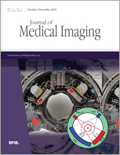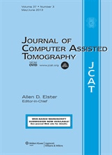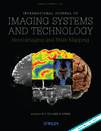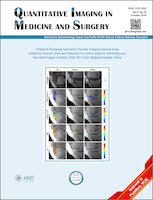
Journal of Medical Imaging
Scope & Guideline
Exploring the Intersection of Optics and Imaging Technologies
Introduction
Aims and Scopes
- Innovative Imaging Techniques:
The journal publishes research on cutting-edge imaging technologies, including advancements in CT, MRI, ultrasound, and hybrid imaging systems. This includes studies that explore the development of new imaging modalities and their applications in various medical fields. - Artificial Intelligence and Machine Learning in Imaging:
A significant focus of the journal is the integration of AI and machine learning techniques in medical imaging. This encompasses automation in image analysis, segmentation, and diagnosis, as well as the development of AI algorithms to enhance imaging performance. - Image Quality and Quantification:
Research related to image quality assessment, optimization, and quantification metrics is a core area. This includes studies that evaluate the impact of imaging protocols on diagnostic accuracy and patient outcomes. - Clinical Applications and Outcomes:
The journal emphasizes clinical research that demonstrates the application of medical imaging in real-world scenarios, assessing its impact on patient management, treatment planning, and outcomes. - Interdisciplinary Approaches:
JMI encourages interdisciplinary research that combines insights from radiology, engineering, computer science, and clinical medicine to foster innovations in medical imaging.
Trending and Emerging
- Deep Learning for Image Analysis:
Deep learning techniques are increasingly being utilized for various applications in medical imaging, including image segmentation, classification, and enhancement. This trend reflects the growing reliance on AI to improve diagnostic accuracy and efficiency in clinical settings. - Radiomics and Quantitative Imaging:
Emerging interest in radiomics—extracting large amounts of features from medical images—has gained traction. This area focuses on the quantification of imaging data to predict treatment responses and outcomes, highlighting the role of imaging in personalized medicine. - Integration of Multimodal Imaging:
There is a rising trend in the integration of multimodal imaging approaches, combining data from different imaging modalities to enhance diagnostic capabilities and provide comprehensive insights into patient conditions. - Patient-Centric Imaging Research:
Research that emphasizes patient outcomes and experience is becoming more prominent. This includes studies that assess the impact of imaging on treatment decisions and overall patient management. - Addressing Bias and Fairness in AI:
Research focused on identifying and mitigating biases in AI algorithms used for medical imaging is gaining importance. This reflects a broader awareness of the need for fairness and equity in healthcare technologies.
Declining or Waning
- Traditional Imaging Techniques:
Research centered on conventional imaging methods without integration of advanced technologies has become less frequent. This trend indicates a shift towards more sophisticated imaging modalities or techniques that incorporate AI and machine learning. - Basic Image Processing Techniques:
While foundational image processing techniques remain important, the focus on basic algorithms without novel applications or improvements has diminished. Researchers are now more inclined to explore advanced or hybrid methodologies. - Generalized Imaging Protocols:
Studies that propose generalized imaging protocols without specific clinical applications or validations have seen a decline. The trend has shifted towards evidence-based protocols tailored to specific patient populations or conditions.
Similar Journals

JOURNAL OF COMPUTER ASSISTED TOMOGRAPHY
Pioneering Research in Computer-Assisted ImagingJOURNAL OF COMPUTER ASSISTED TOMOGRAPHY, published by Lippincott Williams & Wilkins, stands as a vital resource in the field of Radiology, Nuclear Medicine, and Imaging. Since its inception in 1977, this journal has been dedicated to advancing the understanding and application of computer-assisted tomography, emphasizing innovative research and clinical practices that enhance diagnostic imaging techniques. With an impact factor reflective of its rigorous scholarship and relevance—ranking in the Q3 category—the journal serves as an essential platform for contributors and readers alike, navigating the challenges and opportunities within a rapidly evolving field. Researchers, professionals, and students are encouraged to engage with the rich repository of articles that cover emerging technologies, clinical applications, and theoretical advancements, collectively fostering a deeper comprehension of imaging sciences. Although not currently designated as an open-access journal, it continues to enhance discourse in the community from its headquarters in Philadelphia, PA, maintaining a commitment to the highest standards of academic excellence.

INTERNATIONAL JOURNAL OF IMAGING SYSTEMS AND TECHNOLOGY
Pioneering Research in Imaging Systems and TechnologyINTERNATIONAL JOURNAL OF IMAGING SYSTEMS AND TECHNOLOGY, published by Wiley, is a leading journal dedicated to advancing the field of imaging systems and technologies. With an ISSN of 0899-9457 and E-ISSN 1098-1098, this esteemed journal offers a platform for high-quality research spanning essential interdisciplinary areas, including Biomedical Engineering, Computer Science, and Health Informatics. Recognized for its impactful contributions, it holds a commendable position in the Q2 quartile across multiple categories as of 2023. The journal boasts an excellent Scopus ranking, with notable acknowledgments like rank #49 out of 333 in Radiology, Nuclear Medicine, and Imaging, showcasing its relevance and importance in the academic community. Publishes annually from 1989 to 2024, it aims to bridge gaps in knowledge and foster innovative developments through rigorous peer-reviewed articles. Though it operates under a traditional access model, the journal maintains an accessible repository of cutting-edge research, making it indispensable for researchers, professionals, and students alike seeking to stay at the forefront of imaging technology advancements.

Quantitative Imaging in Medicine and Surgery
Advancing Imaging Science for Better Patient OutcomesQuantitative Imaging in Medicine and Surgery is an esteemed journal dedicated to advancing the field of medical imaging through rigorous research and innovative methodologies. Published by AME PUBLISHING COMPANY in China, this journal has established itself with an impressive Q2 quartile ranking in the field of Radiology, Nuclear Medicine, and Imaging, reflecting its dedication to high-quality research. With a comprehensive focus on quantitative imaging techniques, the journal covers a wide range of topics including image analysis, imaging biomarkers, and the integration of imaging in clinical practice, promoting collaboration between imaging specialists and clinicians. As an open access journal, Quantitative Imaging in Medicine and Surgery ensures that its articles are freely accessible, facilitating the dissemination of knowledge to a broader audience. With a commitment to fostering innovation in imaging science, this journal serves as an invaluable resource for researchers, professionals, and students alike, ultimately aiming to improve patient outcomes through advanced imaging strategies and technologies.

JOURNAL OF DIGITAL IMAGING
Elevating Standards in Radiology and Ultrasound TechnologiesJOURNAL OF DIGITAL IMAGING, published by Springer, is a premier journal dedicated to the field of digital imaging, encompassing significant developments in the intersecting disciplines of radiology, computer science applications, and ultrasound technology. With its impressive Q1 ranking in the categories of Radiology, Nuclear Medicine and Imaging, and Radiological and Ultrasound Technology, and a substantial Q2 ranking in Computer Science Applications, this journal is positioned at the forefront of research dissemination in these vital areas. The ISSN 0897-1889 and E-ISSN 1618-727X signify its broad reach and accessibility, while its Scopus rankings demonstrate its robust impact in the academic community, ranked #41/333 in Radiology and earning a notable 87th percentile status. Since its inception in 1988, the journal has served as a vital resource for researchers and professionals seeking to advance their understanding of digital imaging technologies and their applications. Although it does not currently offer open access options, it continues to foster scholarly dialogue and innovation, making it an indispensable platform for those committed to excellence in imaging science and technology.

Egyptian Journal of Radiology and Nuclear Medicine
Empowering Knowledge in Radiology and Nuclear MedicineThe Egyptian Journal of Radiology and Nuclear Medicine, published by Springer, is a premier open access journal that has provided valuable insights and advancements in the fields of radiology and nuclear medicine since its initiation in 2010. With an E-ISSN of 2090-4762, this journal is dedicated to bridging the gap between research and clinical practice, allowing for the dissemination of high-quality research to a global audience. Situated in Germany, it enjoys a robust reputation in the academic community, evidenced by its categorization in the Q3 quartile for 2023, as well as its Scopus ranking, where it holds a position of #225 out of 333 in the domain of Radiology, Nuclear Medicine and Imaging, placing it in the 32nd percentile. The journal's open access model ensures that researchers, professionals, and students can freely access innovative studies, reviews, and case reports that discuss the latest methodologies, technological advancements, and clinical outcomes in radiology and nuclear medicine. As it looks toward its converged years spanning from 2010 to 2024, the Egyptian Journal of Radiology and Nuclear Medicine continues to be an essential resource for advancing knowledge and fostering ongoing collaboration in these critical fields.

ROFO-FORTSCHRITTE AUF DEM GEBIET DER RONTGENSTRAHLEN UND DER BILDGEBENDEN VERFAHREN
Empowering Knowledge in Radiological AdvancementsROFO-Fortschritte auf dem Gebiet der Röntgenstrahlen und der bildgebenden Verfahren, published by Georg Thieme Verlag KG, is a pivotal journal in the fields of radiology and nuclear medicine, offering invaluable insights for researchers, healthcare professionals, and students alike. With an ISSN of 1438-9029, this journal has been a stalwart of scientific communication since its inception in 1975, actively contributing to advancements in imaging techniques and radiation therapy. Although it operates under traditional access, the journal maintains a respectable standing, reflected by its Q3 ranking in Radiology, Nuclear Medicine and Imaging and Q4 in Medicine (miscellaneous), highlighting its significance in the scholarly community. Its coverage spans a wide array of topics pertinent to diagnostic imaging and therapy protocols, making it an essential resource for anyone seeking to understand the complexities of modern radiological practices. As the journal continues to evolve through 2024, it invites contributions that enrich the dialogue around technological innovations and clinical applications in the realm of imaging modalities.

EUROPEAN JOURNAL OF RADIOLOGY
Exploring the Frontiers of Medical ImagingThe European Journal of Radiology, published by Elsevier Ireland Ltd, is a premier peer-reviewed journal in the fields of radiology, nuclear medicine, and imaging. Established in 1981, it has carved a significant niche within the academic community, showcasing innovative research that enhances medical imaging practices and improves patient care. With an impressive ranking in the Q1 category for both Medicine (miscellaneous) and Radiology, Nuclear Medicine, and Imaging in 2023, the journal is recognized globally for its commitment to advancing scientific knowledge and improving imaging methodologies. The journal's Scopus ranking of #60/333, placing it in the 82nd percentile, underlines its reputation for high-quality research and scholarly contributions. While traditionally a subscription-based journal, it continually evolves to meet the demands of the academic landscape, aiming to bridge the gap between research and clinical practice. Researchers, healthcare professionals, and students alike can benefit from exploring its extensive archives and current publications, which are curated to foster education and innovation in the medical imaging domain.

Current Medical Imaging
Elevating Standards in Radiology and Internal MedicineCurrent Medical Imaging is a reputable journal published by Bentham Science Publishers, specializing in the dynamic field of medical imaging, with a strong emphasis on both clinical applications and technological advancements. Established in 2007, the journal has made significant contributions to the fields of Internal Medicine and Radiology, consistently ranking in the Q3 quartile for these categories as of 2023. The journal's ISSN 1573-4056 and E-ISSN 1875-6603 ensure wide accessibility for scholarly communication, although it operates under a traditional access model. With its continuous publication from 2011 to 2024, Current Medical Imaging aims to bridge the gap between advanced imaging techniques and their practical application in patient care, making it indispensable for researchers, healthcare professionals, and students eager to stay at the forefront of innovations in imaging technology and clinical practice.

Physica Medica-European Journal of Medical Physics
Advancing the Frontiers of Medical PhysicsPhysica Medica - European Journal of Medical Physics is a premier peer-reviewed journal published by ELSEVIER SCI LTD, dedicated to advancing the field of medical physics. Established in 1989 and serving as a critical platform for innovative research, this journal covers a broad spectrum of topics within biophysics, radiology, and imaging sciences, consistently ranked in the Q1 category across these disciplines. With an impressive impact factor that highlights its influence within the scientific community—ranking 52/333 in Radiology, 42/243 in Physics and Astronomy, and 35/152 in Biochemistry—the journal is a valuable resource for professionals, researchers, and students aiming to contribute to the technological and methodological advancements in medical physics. Physica Medica is committed to fostering open dialogue and collaboration within the global medical physics community, although it currently does not offer open access options. The journal's extensive citation history and ongoing relevance underscore its importance in the continuous evolution of medical science.

BMC MEDICAL IMAGING
Empowering Researchers and Clinicians in Medical Imaging.BMC Medical Imaging is a premier open-access journal dedicated to advancing the field of radiology, nuclear medicine, and imaging technologies. Published by BMC in the United Kingdom, this journal serves as a vital resource for researchers, clinicians, and students, fostering a collaborative environment for sharing innovative findings and methodologies in medical imaging. With a commendable impact factor and an impressive Scopus ranking within the top 35% of its category, BMC Medical Imaging provides a platform for high-quality research to be disseminated widely and freely since its inception in 2001. The journal aims to cover a diverse array of topics, from advanced imaging techniques to their clinical applications, enhancing the understanding and effectiveness of diagnostic practices. By contributing to the body of knowledge and facilitating open access to research, BMC Medical Imaging plays a pivotal role in shaping the future of medical imaging and improving patient care.